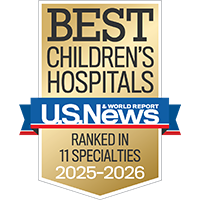Saving future lives
500+ UCSF investigators are researching cures for hundreds of childhood and adult diseases.


Persistent pulmonary hypertension of the newborn, or PPHN, occurs when a newborn's circulation system doesn't adapt to breathing outside the womb.
While in the womb, the fetus receives oxygen through the umbilical cord, so the lungs need little blood supply. There is high blood pressure in the lungs, so blood in the pulmonary artery is sent away from the lungs to the other organs through a fetal blood vessel, called the ductus arteriosus.
Normally, when a baby's born and begins breathing, the blood pressure in the lungs falls and blood flow to the lungs increases. Oxygen and carbon dioxide are exchanged in the lungs, then the blood is returned to the heart and pumped back out to the body. The ductus arteriosus constricts and permanently closes in the first day of life.
In babies with PPHN, the pressure in the lungs stays high and the ductus arterious remains open, allowing blood to be directed away from the lungs. PPHN is a rare but life-threatening condition that appears most often in full-term or post-term babies who have had a difficult birth or conditions such as infection or birth asphyxia.
The signs and symptoms of persistent pulmonary hypertension of the newborn may include:
Various imaging and laboratory tests can help determine if a baby has persistent pulmonary hypertension of the newborn. These may include:
In treatment for PPHN, the main goal is to increase oxygen flow to the baby's organs to prevent serious health problems. Treatment may include a wide range of mechanical ventilation and respiratory therapy options such as:
In addition, an extracorporeal membrane oxygenation (ECMO) machine may be used for babies who are experiencing serious heart or lung failure. The ECMO delivers oxygen to the brain and body as temporary support while the PPHN resolves. ECMO is similar to a heart-lung bypass machine, which takes over your baby's heart and lung functions with an external pump and oxygenator. Blood is drained from the baby to an artificial lung, where oxygen is added and carbon dioxide is removed, then the blood is pumped back into your child.
At UCSF Benioff Children's Hospital, we treat over 20 patients each year with ECMO and our success outcomes are among the highest in the country. Our team includes a neonatologist, surgeon, respiratory therapists and nurses with special training in the management of ECMO.
UCSF Benioff Children's Hospitals medical specialists have reviewed this information. It is for educational purposes only and is not intended to replace the advice of your child's doctor or other health care provider. We encourage you to discuss any questions or concerns you may have with your child's provider.

Ranked among the nation's best in 11 specialties
Saving future lives
